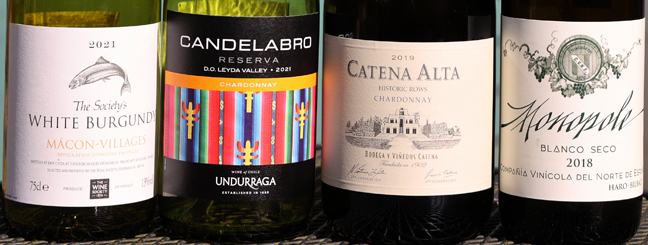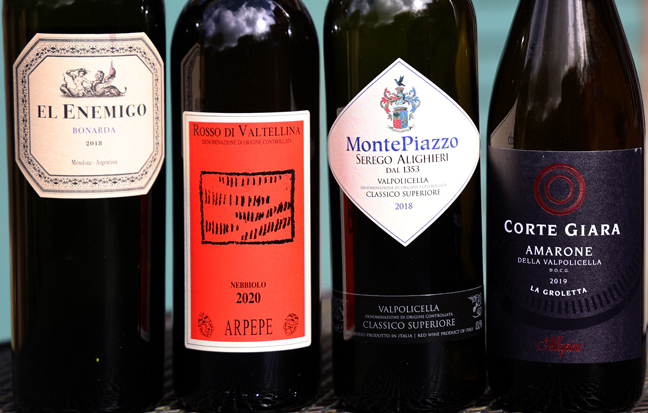 Wood and Wine: a world of alchemy with Nancy Gilchrist MW
Wood and Wine: a world of alchemy with Nancy Gilchrist MW
It was a dark and stormy night at the Cherwell Boathouse on 22 March when Nancy took us deep into the depths of the forests … and led us out safely with a brilliant display of entertainment, erudition and fascinating wines.
The wine world, said Nancy, is perhaps just at the beginning of a third age of oenology. In the beginning (aka the 1970s) it was all about the cellars and the wineries. Wine, we thought, was made in the winery. Then in the 1990s came the vineyard revolution. Issues of leaf cover, planting density, vineyard management, soil treatment, micro-climatic effects dominated the discourse. And now we are entering the age of wood.
It’s not that the partnership of wood and wine is a new one. Wooden casks have been used to ferment, mature and store wine for millennia. What is new though is the technical advances that are adding science to the age-old art and expertise of the coopers.
A combination of DNA and chemical analysis of the wine itself enables us to identify not just the type of wood that has been used to produce the wine but to trace the wood back to specific forests. More than that, we can also identify the chemical compounds produced in the wine by that wood. Hence the winemaker can increasingly fine tune his or her processes to generate the specific aroma, flavours and mouthfeel required.
Different woods and different use of those woods give very different aromas and flavours to the wine and Nancy used a combination of wonderful photographs, forest-location maps and her own clear exposition to make these differences clear to us. Most of the wood used by coopers for wine still comes from French forests - a legacy in part of Jean-Baptiste Colbert, the French minister who planted forests such as the Allier and Tronçonnais over four hundred years ago and ensured that the practice of planting oak trees has continued since then. These forests, which still dominate top-end winemaking, are of two different oak species: quercus robur or quercus petraea. The wood of these trees is finer-grained than the most-used American oak - quercus alba - which comes from forests in Pennsylvania and Missouri. Eastern European wood from forests in Romania, Slovenia and Hungary is increasingly important to the wine trade. It’s not only that they can supply lower-priced French oak but the forests there are important source of other woods such as acacia, chestnut, cherry – though Italy is both the major user and major source of chestnut and cherry.
It is becoming increasingly clear that micro-climatic and terroir influences are as vital to the quality of the wood as they are to the grapes. In general, American oak trees grow faster than French. That creates a more open, less fine-grained cellular texture which in turn makes the transfer of flavour compounds quicker and easier. Denser woods also take longer to dry out sufficiently for use with wine. French oak wood is air-dried; most American oak is kiln-dried. Kiln-drying is not only far faster (weeks rather than the 3-5 years of French oak) but gives different flavouring to the wine. By contrast, air-drying oak allows wind and rain to slowly leach out tannins and creates wood that is almost impossible to saw but easier to bend to shape, though, unlike kiln-dried wood, it is more prone to warping and twisting in the barrel-making process.
Because French oak is impossible to saw into staves it has to be split, a laborious and highly skilled task but one which means that a proportion of each trunk is wasted. A single 130 year-old oak tree makes no more than 2-3 barriques. By contrast American oak can be sawn into staves far more easily and with less wastage. The staves need to be bent into shape to form the barrel and there are different techniques used. Immersion in near-boiling water is one technique, steam-bending another but traditional barrels are laboriously bent into shape over an open fire by the coopers. This process chars or ‘toasts’ the oak but there’s always the danger that over-exposure to heat can kill the vanillin which is so important to many red wines. Judging the precise amount of toast is one reason it takes a full five years of apprenticeship to become a master cooper. The barrel shape formed there’s still the ‘head’ to make. You can saw these pieces of the structure but - at the top end - you need to use specially grown female bullrushes to produce the glue that keeps the head watertight yet allows it to flex slightly with the barrel. But this specialised knowledge of craft is now spreading. French cooperages have set up in America, are introducing air-drying and learning how to make the most of American oak.
One consequence of the variation in woods and their treatment is that the price per barrel varies enormously. Kiln-dried barrels from Eastern Europe range from $360-500; top end French barrels can cost over $3500. Mouton Rothschild’s barrel room holds some 1000 barrels - that’s around $1,500,000 worth of stock before they receive even a drop of wine. Of course, these barrels - which will be used for only a few years - have a second-hand value. They hold Mouton Rothschild yeast - and what winemaker wouldn’t relish some of that in their cellar. The longer a barrel is used the less the flavour that it imparts - a ‘tremendous impact’ in the first year and rapidly falling thereafter. By year 4 they no longer impart much flavour or tannin to the wine - but they do have other advantages. After this time the pores of the wood which allow for micro-oxygenation whilst remaining wine-tight are ‘clogged’ with wine sediment. This slows down yet further the inflow of oxygen so the wine ages more slowly and, ultimately, more smoothly. The staves can be ‘shaved’ to reveal a fresh level of flavour but this reduction in thickness has the downside of speeding up the oxygen flow.
If you can’t or won’t afford full-on oak barrels there are still ways of getting the impact of oak. Oak powder is the lowest level, next up is chips and at the top end there are staves which can either be dangled into the wine like an oaky teabag or be built into the framework of the barrel to further increase their impact. What’s more the winemaker can mix woods - an oak barrel with cherry staves to accentuate red fruit flavours for example. Chips, which in the past had a poor reputation, are steadily improving. The problem in the past was that they produced wines which were a bit ‘Smartie’ like - an outside veneer of flavour rapidly giving way to a less refined taste. But now, as our first set of white wine samples showed, the aromas and flavours are well integrated and telling the two treatments apart is getting harder. There’s a big cost impact though - French oak adds around 98p a litre to the bottle cost versus under 5p a litre if you use chips.
Once in the cellar, there are still influencing factors at play. Where in the cellar? In Jerez, closeness to the sea or height above the sea affects humidity and ageing. Closer to the sea the wine acquires a more saline quality. Humidity can also be managed by spraying water, while evaporation levels can be changed by rolling barrel so that the bung is off centre. So much to consider as we tasted the first four wines…
Wine no 1 was the Wine Society’s Macon-Villages (a quality bargain at £12.95). This was our ‘control’ wine - fermented and aged in stainless steel. This was rich and well-concentrated with notes of lemon and grapefruit and tropical fruits. Next up was a 2021 Chardonnay, the Candelabro Reserva from Underraga, based in the Leyda Valley in Chile. This is one of the oldest properties in Chile with its founder bringing in cuttings from Europe in the 1870s. A stronger, golden hue to the eye with discrete vanilla and rich tree fruits on the nose demonstrated the progress of chips and the increased precision with which winemakers handle them.
and aged in stainless steel. This was rich and well-concentrated with notes of lemon and grapefruit and tropical fruits. Next up was a 2021 Chardonnay, the Candelabro Reserva from Underraga, based in the Leyda Valley in Chile. This is one of the oldest properties in Chile with its founder bringing in cuttings from Europe in the 1870s. A stronger, golden hue to the eye with discrete vanilla and rich tree fruits on the nose demonstrated the progress of chips and the increased precision with which winemakers handle them.
Wine no 3 was many members’ wine of the evening. This was the Catena Alta 2019 Historic Rows Chardonnay. In this context ‘historic’ means 50-80 year-old vines grown at around 900 metres and irrigated through a complex system of channels - remarkably akin to the Madeiran levadas. Fermented in stainless steel and then matured for 14 months in French oak. The Catena Alta was much more intensely focused with a more savoury nose (nutmeg perhaps) as well as vanilla and roasted nuts. In the mouth a touch of tannin from the oak of the barrels (don’t believe those who say white wine has no tannin).
The final white wine was the 2018 Monopole Clasico Seco from CVNE. This white Rioja was made from Viura grown at 600 metres. Fermented in stainless steel and concrete but then aged first for eight months in American oak barriques before a blending period in Manzanilla barrels which added a distinct and appealing touch of oxidation. This had a deeper colour than previous wines and a richer, more expressive nose of pear, apple and white flowers with a hint of spice that oxidative effect from the sherry barrels added complexity and edge to the wine on the palate and in the finish.
 From white wines we moved to a set of four reds. First up was a 2018 Bonarda from Mendoza. ‘El Enemigo’ (and yes, it does mean the ‘enemy’) is made by the rather Zorro-like Alejandro Vigin (we had a distinctly Byronic picture of a winemaker apparently wrestling for his soul with the universe). This is not the same as the Italian Bonarda. Alejandro’s wine (which has 15% Cab Franc in the mix as well) was inky black with a narrow pink rim and high acidity. Fresh black fruit prevails with no indication of oak on the nose, and with tannins that have been polymerised and softened. This is down to ageing not in new oak but 100 year-old French foudres.
From white wines we moved to a set of four reds. First up was a 2018 Bonarda from Mendoza. ‘El Enemigo’ (and yes, it does mean the ‘enemy’) is made by the rather Zorro-like Alejandro Vigin (we had a distinctly Byronic picture of a winemaker apparently wrestling for his soul with the universe). This is not the same as the Italian Bonarda. Alejandro’s wine (which has 15% Cab Franc in the mix as well) was inky black with a narrow pink rim and high acidity. Fresh black fruit prevails with no indication of oak on the nose, and with tannins that have been polymerised and softened. This is down to ageing not in new oak but 100 year-old French foudres.
The next wine was not only fermented but also aged in large old chestnut casks. This was a 2020 Nebbiolo Arpepe (winemaker Arturo Perego’s use name) from the Rosso di Valtellina DOC in northern Italy. Nancy’s pictures revealed the scale of the winemaking challenge. The steep terraced slopes of granite and schist mean that grapes sometimes have to be helicoptered out. Apparently there is an official category of ‘Heroic Vineyards, to qualify for which they have to be at an altitude of over 500 metres and with slopes at more than 30 degrees. Arturo’s Nebbiolo was cherry red with a nose of red berries, rhubarb and a hint of nuts and mushrooms. Tart, even astringent in the mouth and in the finish with fine, slightly sandy tannins. A delicate wine, this would be over-powered by French oak hence the use of chestnut which, in general, has only a small impact on flavour and colour.
Wines nos 7 and 8 were both from Valpolicella- but different styles and quite different tastes. The 2019 Monte Piazzo from Alighieri was a blend of Corvina, Rondinella and Molinara (the Alighieri’s own clone). Unusually it is is semi-appassimento (rather than the full on appassimento for an Amarone). Deep in colour with a broadening brownish tinge to the rim. Red/black fruit with a strong hint of coffee grounds overlaid in the mouth with a touch of balsamic vinegar. Again rather unusually, this is aged for four months in cherry wood but it was hard to detect any specific effects. For coopers, cherry wood has the advantage that it can be sawn but the disadvantage that it is not always water-tight which means that spoilage can be a risk until the barrels have had time to become clogged with wine sediment. In general, the wood contributes cherry and red fruit flavours to wine.
No 8, the last of the reds, was an Amarone della Valpolicella made with a blend of 70% Corvina and 30% Rondinella passito. The grapes are air-dried for 3-4 months (losing 40% of their weight in the process), fermented to dry and then aged for 15 months in large Slavonian oak foudres. Dark red in colour, with a warm spicy nose and lots of dense but not at all harsh tannins.
The last wine of a fascinating - and extraordinarily well-received tasting - was a 2018 Santa Christina Vin Santo from the Antinori stable. Trebbiano and Malvasia grapes, dried for 5 months on straw mats and then slow fermented with indigenous yeasts and matured in 50 litre carritelli oak barrels. 14% natural alcohol with an elevated, rancio aroma and great length.
the Antinori stable. Trebbiano and Malvasia grapes, dried for 5 months on straw mats and then slow fermented with indigenous yeasts and matured in 50 litre carritelli oak barrels. 14% natural alcohol with an elevated, rancio aroma and great length.
The issue of barrel size is yet another source of different expressions in the finished wine. This is a tricky area, not just technically but also linguistically, since barrels change names and sizes as they cross regional or national boundaries. Burgundy tonneaux are bigger than those in Bordeaux; foudres can be anything from 500 to over 1000 litres in capacity. In general larger barrels means less flavour since less of the wine is exposed to the wood.
Oak, cherry and chestnut are not the only woods used for wine. Acacia (or the black locust tree) is fairly frequently used in Eastern Europe, particularly for white wines made from neutral or aromatic grapes. It has little effect on aroma and flavour but tends to add a yellow note to the wine and produces a slightly ‘waxy’ texture.
Club members were unanimous in their appreciation of this absorbing and deeply researched tasting. That’s not to say that everyone liked all the wines but the clarity of Nancy’s explanations and the evident distinctions in style imparted by different wood treatments to the wines, particularly the four whites, gave us all a far deeper understanding of the complex relationship between wine and wood - and the strong sense that, as Nancy said, this is still an unfolding science -and an unfolding story.
And if that gives us a chance to tempt Nancy back in a year or so with an update on the world of wood, then there would a large number of very pleased Club members. Thank you, Nancy.
GH: 24/3/23